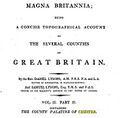Lysons
Life
Daniel Lysons (1762–1834) was an English antiquarian and topographer, who published amongst other works the four-volume Environs of London (1792–96). He collaborated on several works with his antiquarian younger brother Samuel Lysons (1763–1819). Samuel Lysons FSA FRS (1763 – June 1819) was an English antiquarian and engraver. He was one of the first archaeologists to investigate Roman sites in Britain, and specialised in the study of mosaics.
Their most relevant book for Cheshire and Chester is Magna Britannia. Unlike other similar works published in the seventeenth and eighteenth centuries, Magna Britannia is of significant value to economists and social historians because the Lysons brothers included content on topics such as population, manufacture and commerce. They were also far less preoccupied than many antiquarians with coats of arms and pedigrees, and did not overstate the grandeur of the counties, as local topographers were apt to do.
Daniel
Daniel Lysons was the eldest son of Samuel Lysons, rector of Rodmarton and Cherrington, Gloucestershire, by Mary, daughter of Samuel Peach of Chalford in the same county (Burke, Landed Gentry, 4th edit. p. 921). From Bath grammar school he proceeded to Oxford, matriculating from St. Mary Hall on 26 March 1779. He graduated B.A. in 1782, M.A. in 1785. Taking orders, he became in 1784 curate of Mortlake, and about 1790 curate of Putney, Surrey. During his residence there he commenced his survey of the environs of London. In this design he was encouraged by Horace Walpole, earl of Orford, who appointed him his chaplain, and to whom he dedicated the work. On the death of his uncle, Daniel Lysons, M.D. (1727–1800), he inherited Hempstead Court and the family estates in Gloucestershire. In 1804 he succeeded to the family living of Rodmarton.
In the British Museum are eight volumes of newspaper cuttings, mostly collected by Lysons, with title-pages printed at Strawberry Hill, and arranged as follows: 1. ‘Collectanea; or a Collection of Advertisements and Paragraphs from the Newspapers, relating to various Subjects,’ 2 vols. fol., 1660–1825. 2. ‘Another Collection, relating to Giants, Dwarfs, Balloons,’ &c. With portraits and plates, manuscript notes and index, 5 vols. fol., 1661–1840. 3. ‘Cuttings from Newspapers of 1726–56, relating chiefly to the Life and Orations of John Henley.
Samuel
Samuel Lysons was a lawyer, antiquary and artist who became vice-president and director of the Society of Antiquaries of London. He was a notable figure in British social and intellectual circles in the late eighteenth and early nineteenth centuries, and his volumes on Romano-British remains, ranked among the most sought-after publications of their day. Lysons is widely acknowledged as a founding figure of Romano-British archaeology, and the accuracy of his recording became the model for subsequent scholarship, particularly with regard to the excavation of villas, and the recording and evaluation of mosaics. He was educated at home and subsequently at Bath Grammar School, where he became an excellent Classical scholar. On completion of his education he began a career in the law, was called to the Bar in 1798, and selected the Oxford circuit. However, he did not focus his attention entirely on the law.
While in Bath, Samuel Lysons was quickly integrated into an eminent social circle which comprised famous socialites, intellectuals and artists, such as Mrs Hester Lynch Piozzi, a close friend of author, Samuel Johnson. Both of these have links to Chester: Piozzi via George Angelo Bell who built much of Chester's sewer network and Johnson somewhat more directly as Johnson is known to have visited Chester in 1774. Local folk-law has Johnson scratching a graffitio on the window of Leche House - but there are many legends about the building which may have been "discovered" when it was an antique shop.
When in London Samuel Lysons attended the lectures of Sir Joshua Reynolds and developed his passion for etching. There are around 300 watercolours by Samuel Lysons in the British Library. From 1785 onwards he regularly exhibited drawings at the Royal Academy; these included landscapes, the architecture of churches and castles, and the Woodchester ‘Great Pavement’ in 1795.
Works
With his brother Samuel, Daniel Lysons began Magna Britannia, "being a concise Topographical Account of the several Counties of Great Britain" (1806–1822), but after the first six volumes, covering the counties from B to D (fortunately including Cheshire), Samuel died and the project was discontinued. An earlier work under the same title had been compiled by Thomas Cox (1655? – 1734) .
